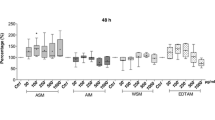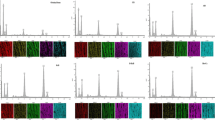Abstract
Scleral cartilage biocalcium (SCBC) powder from skipjack tuna (Katsuwonus pelamis) eyeball scleral cartilage (STESC) was produced using hexane and isopropanol (1:1) for defatting, followed by protein removal using alcalase at different concentrations (1.5–4.5%) for various times (0–180 min). Calcined scleral cartilage (CSC) was also prepared and characterized. The lowest fat remaining in STESC was attained after 6 cycles of defatting (P < 0.05). The use of 1.5% alcalase for 90 min resulted in the highest soluble protein removal, while showed the lowest loss in hydroxyproline. Higher value of calcium (39.90%), phosphorus (18.97%) and L* (87.97) were detected in the CSC powder, compared to SCBC powder (23.28%, 10.99% and 81.77, respectively) (P < 0.05). However, a*, b*, and ∆E* of CSC powder were lower than SCBC counterpart. The mean particle sizes of both powders had a negligible difference (P > 0.05). XRD-diffractogram of both powders confirmed the presence of hydroxyapatite. CSC showed the loss of water, amide I, II, III, and other organic functional group peaks in Fourier transform infrared spectra. Also, smaller number and abundance of volatile compounds were found in CSC powder. STESC showed a higher calcium solubility in gastrointestinal tract than CSC (P < 0.05). Therefore, scleral cartilage of tuna eyeball could be used as an alternative source for producing biocalcium.
Graphical Abstract





Similar content being viewed by others
Data Availability
All data generated or analyzed during this study are included in this published article.
References
Cashman, K.: Calcium intake, calcium bioavailability and bone health. Br. J. Nutr. 87, S169–S177 (2002). https://doi.org/10.1079/BJN/2002534
Jung, W.K., Lee, B.J., Kim, S.K.: Fish-bone peptide increases calcium solubility and bioavailability in ovariectomised rats. Br. J. Nutr. 95, 124–128 (2006). https://doi.org/10.1079/BJN20051615
Benjakul, S., Karnjanapratum, S.: Characteristics and nutritional value of whole wheat cracker fortified with tuna bone bio-calcium powder. Food Chem. 259, 181–187 (2018). https://doi.org/10.1016/j.foodchem.2018.03.124
Idowu, A.T., Benjakul, S., Sinthusamran, S., Pongsetkul, J., Sae-Leaw, T., Sookchoo, P.: Whole wheat cracker fortified with biocalcium and protein hydrolysate powders from salmon frame: characteristics and nutritional value. Food Qual. Saf. 3(3), 191–199 (2019). https://doi.org/10.1093/fqsafe/fyz012
Wijayanti, I., Singh, A., Benjakul, S., Sookchoo, P.: Textural, sensory, and chemical characteristic of threadfin bream (Nemipterus sp.) surimi gel fortified with bio-calcium from bone of asian sea bass (Lates calcarifer). Foods 10, 976 (2021). https://doi.org/10.3390/foods10050976
Wijayanti, I., Singh, A., Prodpran, T., Sookchoo, P., Benjakul, S.: Effect of asian sea bass (Lates calcarifer) bio-calcium in combination with different calcium salts on gel properties of threadfin bream surimi. J. Aquat. Food Prod. Technol. 30(9), 1173–1188 (2021). https://doi.org/10.1080/10498850.2021.1975004
Wijayanti, I., Benjakul, S., Chantakun, K., Prodpran, T., Sookchoo, P.: Effect of asian sea bass bio-calcium on textural, rheological, sensorial properties and nutritive value of indian mackerel fish spread at different levels of potato starch. Int. J. Food Sci. Technol. 57(5), 3181–3195 (2022). https://doi.org/10.1111/ijfs.15651
Wijayanti, I., Benjakul, S., Saetang, J., Prodpran, T., Sookchoo, P.: Soluble asian sea bass bone bio-calcium: characteristics, bioavailability across CaCo‐2 cells and fortification into apple juice. Int. J. Food Sci. Technol. (2022). https://doi.org/10.1111/ijfs.15904
FAO: Globefish Highlights: A Quarterly Update on World Seafood Markets. FAO, Rome (2019)
Kaewdang, O., Benjakul, S., Kaewmanee, T., Kishimura, H.: Characteristics of collagens from the swim bladders of yellowfin tuna (Thunnus albacares). Food Chem. 155, 264–270 (2014). https://doi.org/10.1016/j.foodchem.2014.01.076
Klomklao, S., Benjakul, S.: Protein hydrolysates prepared from the viscera of skipjack tuna (Katsuwonus pelmamis): antioxidative activity and functional properties. Turk. J. Fish. Aquat. Sci. 18, 69–79 (2018). https://doi.org/10.4194/1303-2712-v18_1_08
de Oliveira, D.A., Licodiedoff, S., Furigo Jr, A., Ninow, J.L., Bork, J.A., Podestá, R., Block, J.M., Waszczynskyj, N.: Enzymatic extraction of oil from yellowfin tuna (Thunnus albacares) by-products: a comparison with other extraction methods. Int. J. Food Sci. Technol. 52, 699–705 (2017). https://doi.org/10.1111/ijfs.13324
Pudtikajorn, K., Benjakul, S.: Simple wet rendering method for extraction of prime quality oil from skipjack tuna eyeballs. Eur. J. Lipid Sci. Technol. 122, 2000077 (2020). https://doi.org/10.1002/ejlt.202000077
Pudtikajorn, K., Sae-leaw, T., Singh, A., Benjakul, S.: Mild heating process and antioxidant incorporation increase quality and oxidation stability of oil from skipjack tuna (Katsuwonus pelamis) eyeball. Eur. J. Lipid Sci. Technol. 124, 2000391 (2021). https://doi.org/10.1002/ejlt.202000391
O’Quin, K.E., Doshi, P., Lyon, A., Hoenemeyer, E., Yoshizawa, M., Jeffery, W.R.: Complex evolutionary and genetic patterns characterize the loss of scleral ossification in the blind cavefish Astyanax mexicanus. PLoS ONE 10, e0142208 (2015). https://doi.org/10.1371/journal.pone.0142208
Franz-Odendaal, T.A., Ryan, K., Hall, B.K.: Developmental and morphological variation in the teleost craniofacial skeleton reveals an unusual mode of ossification. J. Exp. Zool. Part B 308, 709–721 (2007). https://doi.org/10.1002/jez.b.21185
Peinado, I., Miles, W., Koutsidis, G.: Odour characteristics of seafood flavour formulations produced with fish by-products incorporating EPA, DHA and fish oil. Food Chem. 212, 612–619 (2016). https://doi.org/10.1016/j.foodchem.2016.06.023
Benjakul, S., Mad-Ali, S., Senphan, T., Sookchoo, P.: Biocalcium powder from precooked skipjack tuna bone: production and its characteristics. J. Food Biochem. 41, e12412 (2017). https://doi.org/10.1111/jfbc.12412
Tacias-Pascacio, V.G., Morellon-Sterling, R., Siar, E.H., Tavano, O., Berenguer-Murcia, A., Fernandez-Lafudente, R.: Use of alcalase in the production of bioactive peptides: a review. Int. J. Biol. Macromol. 165, 2143–2196 (2020). https://doi.org/10.1016/j.ijbiomac.2020.10.060
AOAC: Official Methods of Analysis. Association of Official Analytical Chemists, Maryland (2002)
Idowu, A.T., Benjakul, S., Sinthusamran, S., Sookchoo, P., Kishimura, H.: Protein hydrolysate from salmon frames: production, characteristics and antioxidative activity. J. Food Biochem. 43, e12734 (2019). https://doi.org/10.1111/jfbc.12734
Benjakul, S., Morrissey, M.T.: Protein hydrolysates from Pacific whiting solid wastes. J. Agric. Food Chem. 45, 3423–3430 (1997). https://doi.org/10.1021/jf970294g
Robinson, H., Hodgen, C.: Protein estimation with the biuret method. J. Biol. Chem. 135, 707–725 (1940). https://doi.org/10.1016/S0021-9258(18)73134-7
Bergman, I., Loxley, R.: Two improved and simplified methods for the spectrophotometric determination of hydroxyproline. Anal. Chem. 35, 1961–1965 (1963). https://doi.org/10.1021/ac60205a053
Milenkovic, B., Stajic, J.M., Stojic, N., Pucarevic, M., Strbac, S.: Evaluation of heavy metals and radionuclided in fish and seafood products. Chemosphere 229, 324–331 (2019). https://doi.org/10.1016/j.chemosphere.2019.04.189
Wijayanti, I., Sookchoo, P., Prodpran, T., Mohan, C.O., Aluko, R.E., Benjakul, S.: Physical and chemical characteristics of asian sea bass bio-calcium powders as affected by ultrasonication treatment and drying method. J. Food Biochem. 45, e13652 (2021). https://doi.org/10.1111/jfbc.13652
Chuaychan, S., Benjakul, S., Kishimura, H.: Characteristics of acid- and pepsin-soluble collagens from scale of seabass (Lates calcarifer). LWT 63, 71–76 (2015). https://doi.org/10.1016/j.lwt.2015.03.002
Iglesias, J., Medina, I.: Solid-phase microextraction method for the determination of volatile compounds associated to oxidation of fish muscle. J. Chromatogr. A 1192, 9–16 (2008). https://doi.org/10.1016/j.chroma.2008.03.028
Sinthusamran, S., Benjakul, S.: Physical, rheological and antioxidant properties of gelatin gel as affected by the incorporation of β-glucan. Food Hydrocoll. 79, 409–415 (2018). https://doi.org/10.1016/j.foodhyd.2018.01.018
Steel, R.G.D.: Principles and Procedures of Statistics a Biometrical Approach. McGraw-Hill Book, New York (1997)
Franz-Odendaal, T.A., Vickaryous, M.K.: Skeletal elements in the vertebrate eye and adnexa: morphological and developmental perspectives. Dev. Dyn. 235, 1244–1255 (2006). https://doi.org/10.1002/dvdy.20718
Efthymiopoulos, I., Hellier, P., Ladommatos, N., Russo-Profili, A., Eveleigh, A., Aliev, A., Kay, A., Mills-Lamptey, B.: Influence of solvent selection and extraction temperature on yield and composition of lipids extracted from spent coffee grounds. Ind. Crops Prod. 119, 49–56 (2018). https://doi.org/10.1016/j.indcrop.2018.04.008
Bechtel, P.J., Watson, M.A., Lea, J.M., Bett-Garber, K.L., Bland, J.M.: Properties of bone from Catfish heads and frames. Food Sci. Nutr. 7, 1396–1405 (2019). https://doi.org/10.1002/fsn3.974
Idowu, A.T., Benjakul, S., Sinthusamran, S., Sae-leaw, T., Suzuki, N., Kitani, Y., Sookchoo, P.: Effect of alkaline treatment on characteristics of bio-calcium and hydroxyapatite powders derived from salmon bone. Appl. Sci 10, 4141 (2020). https://doi.org/10.3390/app10124141
Hamada, M., Nagai, T., Kai, N., Tanoue, Y., Mae, H., Hashimoto, M., Miyoshi, K., Kumagai, H., Saeki, K.: Inorganic constituents of bone of fish. Fish. Sci. 61, 517–520 (1995). https://doi.org/10.2331/fishsci.61.517
Garner, S.C., Anderson, J., Ambrose, W.: Skeletal Tissues and Mineralization. In: Anderson, J.J.B., Garner, S.C. (eds) Calcium and Phosphorus in Health and Disease. CRC Press, Boca Raton (1995)
Pisecky, J.: Handbook of Milk Powder Manufacture Copenhagen Niro A. A/S (1997)
Onwulata, C.: Encapsulated and Powdered Foods. CRC Press, Boca Raton (2005). https://doi.org/10.1201/9781420028300
Londoño-Restrepo, S.M., Jeronimo-Cruz, R., Millán-Malo, B.M., Rivera-Muñoz, E.M., Rodriguez-García, M.E.: Effect of the nano crystal size on the X-ray diffraction patterns of biogenic hydroxyapatite from human, bovine, and porcine bones. Sci. Rep. 9, 1–12 (2019). https://doi.org/10.1038/s41598-019-42269-9
Piccirillo, C., Silva, M., Pullar, R., Cruz, D., Jorge, I.B., Pintado, R., Castro, M.: Extraction and characterisation of apatite-and tricalcium phosphate-based materials from cod fish bones. Mater. Sci. Eng. C 33, 103–110 (2013). https://doi.org/10.1016/j.msec.201208.014
Choël, M., Deboudt, K., Osán, J., Flament, P., Van Grieken, R.: Quantitative determination of low-Z elements in single atmospheric particles on boron substrates by automated scanning electron microscopy-energy-dispersive X-ray spectrometry. Anal. Chem 77(17), 5686–5692 (2005). https://doi.org/10.1021/ac050739x
Liu, H., Wu, G., Song, H., Zhang, H., Ma, L., Brennan, C., Li, S., Liu, Y., Wu, J., Wang, Q.: Characterisation of antibacterial peptide fractions extracted from pomelo nucleus co-incubated with Lactobacillus. Int. J. Food Sci. Technol. 55, 2197–2207 (2020). https://doi.org/10.1111/ijfs.14473
Denekamp, I.M., Antens, M., Slot, T.K., Rothenberg, G.: Selective catalytic oxidation of cyclohexene with molecular oxygen: radical versus nonradical pathways. ChemCatChem. 10, 1035–1041 (2018). https://doi.org/10.1002/cctc.201701538
Benjakul, S., Mad-Ali, S., Sookchoo, P.: Characteristics of biocalcium powders from pre-cooked tongol (Thunnus tonggol) and yellowfin (Thunnus albacores) tuna bones. Food Biophys. 12, 412–421 (2017). https://doi.org/10.1007/s11483-017-9497-0
Goss, S., Prushko, J., Bogner, R.: Factors affecting calcium precipitation during neutralisation in a simulated intestinal environment. J. Pharm. Sci. 99, 4183–4191 (2010). https://doi.org/10.1002/jps.22131
Acknowledgements
This work was supported by Faculty of Agro-Industry, Prince of Songkla University under Agro-industrial practice project scholarship. Additionally, NSTDA chair professor grant (P-20-52297) and Prince of Songkla University (Grant No. AGR6502111N) were also acknowledged. Authors would like to thank Chotiwat manufacturing company, Ltd for providing the samples for this study.
Author information
Authors and Affiliations
Corresponding author
Ethics declarations
Conflict of interest
The authors have no relevant financial or non-financial interests to disclose.
Additional information
Publisher’s Note
Springer Nature remains neutral with regard to jurisdictional claims in published maps and institutional affiliations.
Rights and permissions
Springer Nature or its licensor (e.g. a society or other partner) holds exclusive rights to this article under a publishing agreement with the author(s) or other rightsholder(s); author self-archiving of the accepted manuscript version of this article is solely governed by the terms of such publishing agreement and applicable law.
About this article
Cite this article
Pudtikajorn, K., Sae-leaw, T., Yesilsu, A.F. et al. Process Development and Characteristics of Biocalcium from Skipjack Tuna (Katsuwonus pelamis) Eyeball Scleral Cartilage. Waste Biomass Valor 14, 2909–2922 (2023). https://doi.org/10.1007/s12649-023-02075-x
Received:
Accepted:
Published:
Issue Date:
DOI: https://doi.org/10.1007/s12649-023-02075-x




